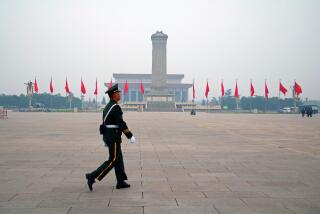ARCHITECTURE : New Home Bringing Britain’s Secret Service in From the Cold
- Share via
LONDON — Through its 83-year history, Britain’s Secret Intelligence Service has lived up to its title: The government has never officially acknowledged its existence.
And unlike its counterparts--the U.S. Central Intelligence Agency and Russia’s KGB--the British spy service’s headquarters here is an unmarked high-rise London office building, which security guards identify only as “Ministry of Defense.”
But the new headquarters of SIS, also known as MI-6, is coming in from the cold--in the form of a new, postmodern building designed by architect Terry Farrell at a commanding position along the Thames River.
The honey-colored concrete and green glass building--with jazzy angles and setbacks--is being built at a cost of nearly $300 million and is expected to become an architectural landmark.
Initial questions about the building were parried by government sources suggesting that it was a branch of the Foreign Office. The architect’s office says only that the building is for a “government department.”
But Foreign Office sources, under new openness guidelines introduced by Prime Minister John Major, admit the true nature of the structure--as has the CIA of its Langley, Va., base and the KGB of its once-dreaded Lubyanka in Moscow’s Dzerzhinsky Square.
The SIS site is isolated at the south bank end of Vauxhall Bridge, across the river from the Tate Gallery.
Originally part of the military, hence MI-6 for Military Intelligence, the SIS is charged with overseas espionage, functioning like the CIA with which it has close ties. It has a staff estimated at about 2,000, with not more than 500 intelligence officers, worldwide. Among its employees or collaborators have been writers Rudyard Kipling, T. E. Lawrence, Graham Greene, Malcolm Muggeridge, Ian Fleming and John le Carre.
In contrast, Britain’s Security Service, or MI-5, is, like the FBI, charged with internal security. It targeted Soviet spies and British double agents but now largely focuses on the Irish Republican Army. Its statutory existence was acknowledged in 1989.
With the decline of the threat from the Soviet Union, British foreign intelligence is attempting to focus on the newly created Eastern republics with their myriad languages.
The SIS will also concentrate, sources say, on nuclear weapons proliferation, terrorism, drugs and tracking ex-Soviet weaponry.
MI-5 is also moving from its Curzon Street headquarters to a refitted building along the Thames diagonally across the river from SIS. Long competitive and often antagonistic, MI-6 and MI-5 will, thus, be able to keep an eye, literally, on each other.
More to Read
Sign up for Essential California
The most important California stories and recommendations in your inbox every morning.
You may occasionally receive promotional content from the Los Angeles Times.













